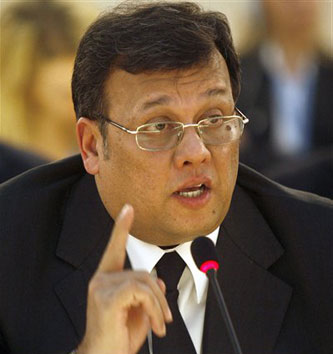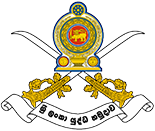 MORE THAN 23,000 persons have been released for return and resettlement in the Jaffna, Ampara, Batticaloa, Trincomalee, Vavuniya and Mannar Districts. A further 9,000 persons belonging to special categories have been handed over to persons or institutions that will care for them. These include orphaned children, members of the clergy and their family members, persons over 60 years of age, university students, public servants and their families, pregnant women and disabled persons.
MORE THAN 23,000 persons have been released for return and resettlement in the Jaffna, Ampara, Batticaloa, Trincomalee, Vavuniya and Mannar Districts. A further 9,000 persons belonging to special categories have been handed over to persons or institutions that will care for them. These include orphaned children, members of the clergy and their family members, persons over 60 years of age, university students, public servants and their families, pregnant women and disabled persons.
The government is aware that there are trained and formerly active members of the LTTE among the IDPs, Minister of Disaster Management and Human Rights Mahinda Samarasingha said at the 60th Session of the Executive Committee of the UN High Commission for Refugees in Geneva yesterday.
Extracts of his speech:
The aims and objectives of the Government of Sri Lanka with regard to Sri Lankan IDPs can be encapsulated in the following terms as expressed by Sri Lanka’s Prime Minister in his address to the UN General Assembly in New York, just two days ago on 26 September. He said: "With the defeat of the LTTE, in May this year, approximately 290,000 civilians in the Vanni region were liberated from the decades - long hold of the LTTE. One of our highest priorities thereafter has been to meet the immediate humanitarian needs of these displaced civilians and to ensure their long-term safe, voluntary and dignified return to their homes. The welfare of our people at present in temporary transit sites must keep up with standards that meet our own high expectations as well as accepted international norms. This task has been facilitated by the assistance we receive from UN agencies, international and local civil society partners and donors."
The Representative of the UN Secretary-General on Human Rights of IDPs, Professor Walter Kälin was in Sri Lanka on a three day visit which concluded over the weekend. He was able to observe, at first hand, the conditions in the welfare villages and the preparations for accelerated resettlement in Mannar District, including de-mining and restoration of vital infrastructure that will sustain and stabilise resettlement and return. Professor Kälin is one international partner of Sri Lanka who has forged a constructive relationship with the country based on open dialogue and frank acknowledgement of the positives as well as the shortcomings that need to be remedied. We welcome such engagement and the sharing of best practice by international experts so that we, as a Government, can develop and fine-tune our responses to challenges that we are called upon to face. We have taken serious note of the concerns expressed by Professor Kälin and other friends and partners relating to the conditions in camps, the issues surrounding freedom of movement and other protection issues.
As I mentioned, there are still persons among the IDPs who have not disclosed their former affiliation with the LTTE. These persons pose a risk not only to IDPs with whom they are intermingled, but, if released, can cause destabilisation and chaos amongst civilians elsewhere in the country. It is for this reason that we have been very careful about releases and permitting full freedom of movement. The Government of Sri Lanka has a responsibility to guarantee the human rights of the entirety of the Sri Lankan population – not only the rights of the IDPs. Allowing LTTE cadres, masquerading as ordinary displaced civilians, freedom of movement could pose a grave threat to people in the rest of the country. The global community knows only too well the atrocities committed by the LTTE against civilian populations. Given the sizeable stores of arms, ammunition and explosives being recovered on a daily basis in the former theatre of conflict and outside that area, the ability of the remnants of the LTTE to carry out indiscriminate acts of terrorism must not be underestimated. This does not mean that attempts to characterise the welfare centres and relief villages as "internment camps" are in any way justified. Limited freedom of movement has been permitted and with the completion of screening, registration and profiling of IDPs, greater freedom of movement would be gradually ensured.
Notwithstanding the foregoing, Mr Chairman, we have released certain categories of persons and plans are under way to invite more persons among the general public to come forward and take care of IDPs. Indeed, advertisements have been placed in national newspapers, especially Tamil Language newspapers, inviting suitable persons to apply to host IDPs. The first round resulted in approximately 2,000 applications which are being processed and more notification, including within the welfare centres and relief villages, will follow.
More than 23,000 persons have been released for return and resettlement in Jaffna, Ampara, Batticaloa, Trincomalee, Vavuniya and Mannar Districts. A further 9,000 persons belonging to special categories have been handed over to persons or institutions that will care for them. These include orphaned children, members of the clergy and their family members, persons over 60 years of age, university students, public servants and their families, pregnant women and disabled persons. We have undertaken to return or resettle the bulk of the IDPs by 31st January commensurating with the 180 day programme for re-settlement. The authorities in charge of maintaining the camps have also put in place a system of day-passes whereby IDPs who need to attend to specific wants, ranging from attending a family wedding, to visiting their bank in a nearby town, can leave the camps for a limited period of time. Furthermore, "go and see visits" are being organised for the rest of the IDPs to ensure that eventual return and resettlement is voluntary and based on an informed choice. This, Mr Chairman, is not typical of the treatment of persons in so-called internment camps.
The return and resettlement programme can only be completed when demining can be completed and we expect to be able to report on major advances in this area during the coming weeks. The acquisition of 10 new flailing machines, using Government funds will enable us to clear much more ground and obtain necessary certification from the United Nations agencies concerned. According to the initial survey carried out by the Information Management System on Mine Action, it is estimated that approximately 1.5 million landmines and unexploded ordnance (UXO) contaminate an area of 402 sq km. Since the beginning of January 2009, de-mining of 25 small administrative divisions has been completed. According to the National Steering Committee on Mine Action, de-mining in 15 divisions in Musali, Manthai West and the Rice bowl area of Mannar covering 80 sqkm have commenced and clearance is on-going. De-mining of the Rice bowl area is expected to be complete by Mid-October to enable further resettlement. In the District of Vavuniya, 35 divisions have already been cleared and are ready for the resettlement of IDPs. De-mining activities in another 10 divisions is ongoing. In Jaffna, de-mining in 14 divisions has been completed with de-mining activities in a further 19 divisions ongoing. While de-mining in 03 divisions in Batticaloa and 01 division in Trincomalee has been completed, clearance activities are ongoing in another 02 divisions each in Anuradhapura, Batticaloa and Trincomalee Districts. As at the end of August, a total of 445,370,401 square meters have been cleared of mines. Approximately US$ 64 million has been allocated for the Sri Lankan Mine Action Programme through the respective de-mining agencies. Of the area cleared, a total of 335,927,614 square meters have been cleared by the Sri Lanka Army at the cost of only US$10 million. The rest of the area has been cleared by other de-mining agencies.
Apart from de-mining, resettlement can only be sustainable if livelihood and other early recovery measures are put in place. The smooth transition from early recovery to medium and longer-term economic development is also being planned for. This long term development strategy is being developed and implemented under a programme known as the "Northern Spring" which will usher in a period of renewal for the people of the North (Courtesy : Island.lk).

